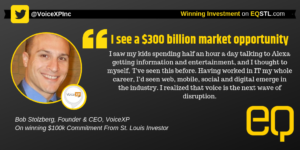
Disrupting Financial and Healthcare Experiences with Kevin Dulle
Kevin Dulle helps define experiences for banks and health systems. Using an understanding of the economic value of experiences, architecture and visual storytelling tools in his role as Director, Experience Innovations at NewGround, he helps clients re-think what it means to connect with customers in the real world.

What does NewGround do?
We’re a design-build firm offering architectural, construction and strategic planning services to the financial services and healthcare industries. We design and build anything from bank branches to headquarters and urgent care centers to medical office centers.
What does “Experience Innovation” have to do with that?
It’s based on looking at the experience of a person in a place as economic value, and how to create or stage experiences to differentiate themselves. We leverage the patient or customer experience so it has more value that just the decor within four walls. It’s the difference between a truck stop coffee shop and a Starbucks.
What tools do you use?
The most powerful tools in my tool box are paper and pen because their infinitely customizable to the client needs. That and lateral thinking—going from convergent to divergent thinking and back again until you get everyone on the same page.
What does that translate to in the end product?
How your experience manifests in the physical world is your brand and business model. Just like Starbucks using their spaces for community gathering and lingering so that people can congregate where they might buy coffee. That gets translated in design to materials, layouts and visual communications all based on the map we create on paper at the beginning.
Tell us about the picture you sent for use with this story—what’s interesting to you about it?
Instead of sending in a photo of me, I thought it more appropriate to use what I do to help tell the story of why, how and what I do through visual thinking and graphic facilitation for others. What most have forgotten or has been educated out of us is the power to actually see an idea, problem or shared thinking. To take the intangible and make it tangible so everyone can see it.
One thing I realized as I was drawing out this Visual Translation was the recurring theme of the blending of art and science throughout my whole life. That blending really manifests itself in what I do for organizations.
What’s the biggest untapped potential you see today for experiences?
We came up with the idea of the Lifestyle Plaza through an ideation session, rethinking healthcare to be patient/consumer focused and a lifestyle destination instead of like a cancer center where you go because you’re sick. Why not treat it like a resort, a theater, a shopping center and make it desirable to be there instead?
Where do you get inspiration?
My first inspiration is often children’s books. They were often meant to teach a lesson, so they use shared parables and metaphors but look outside the box, so they end up being useful in business, too. Dr Seuss, for example.
What’s something you just learned about that you’d like to spend more time exploring?
Gastrophysics—the science behind how the dishes, room decor and all of the sensory cues affect what we taste and what we think of food.
Who in your past helped you become who you are?
Both my parents. My father was an arson investigator, he taught me to dive into the cause and effect of things. My mom was formally trained in botany, and became a florist. She taught me to take risks, to be different and proud. Tom Peters said every company needs a freak, I learned to embrace that from her.
What is the thing most people don’t get at first about what you do?
They don’t get that I do it live, that I draw and discuss with clients in real time as a way to get everyone thinking outside the box. I’m doing it in real-time and making sense of what everyone is saying to get it all to come out on one page.
What current problem would you like to solve?
Too many people take on a project without a clear goal. I’d like to teach everyone the tools I use so they can comfortably visualize where they’re going.
What productivity tools can you not live without?
I use PowerPoint a lot because I’m constantly producing visuals as deliverables. That and big scanners so I can import my big drawings to work with them.
Who else’s work do you admire and why?
Joe Pine and Jim Gilmore, who wrote The Experience Economy to really make sense of how experience can provide greater economic impact than commodities, products or services alone. Also, Tom and David Kelly who started Ideo, who have always gotten how parallel thinking and ideas from other areas can solve problems.
How can people follow you (twitter, blog, events, etc.)?
I’m on Twitter at @IdeaFreak and I blog at TheThinkingCanvas.com.





